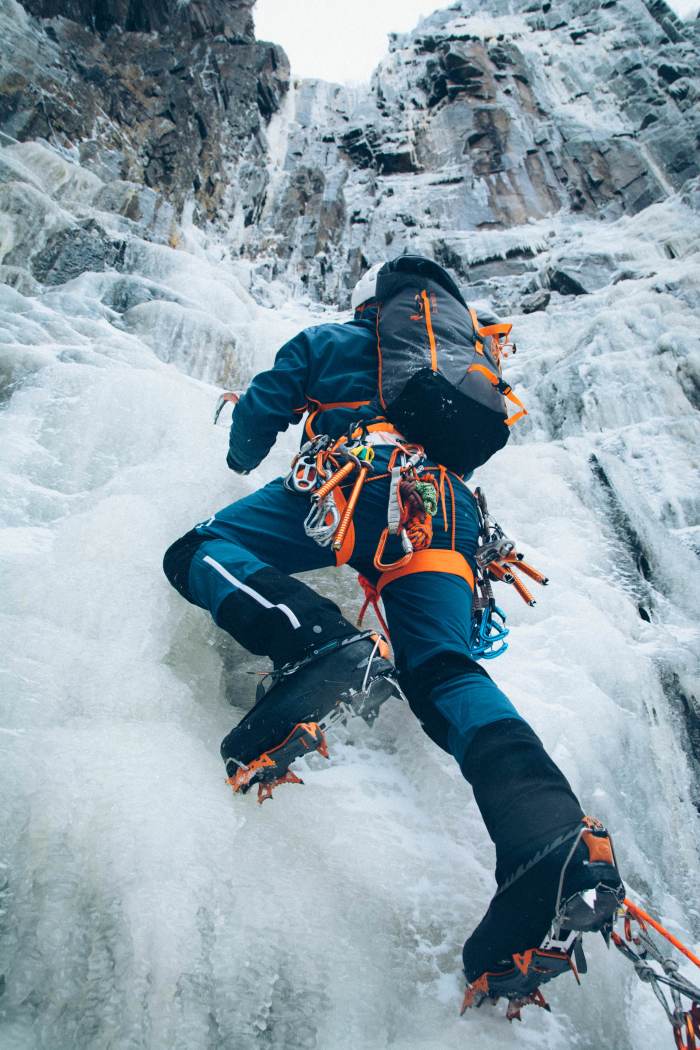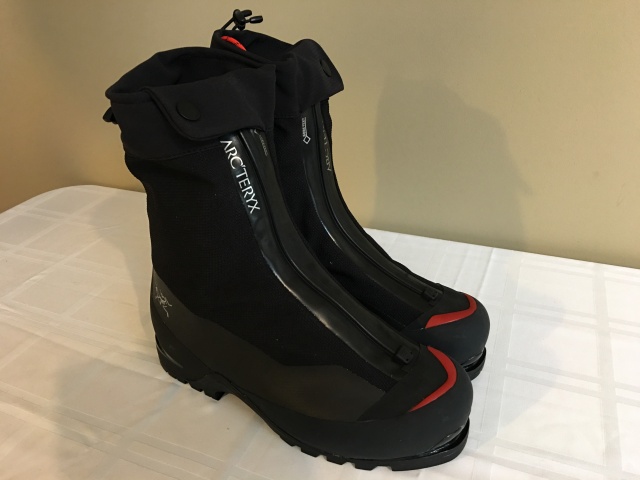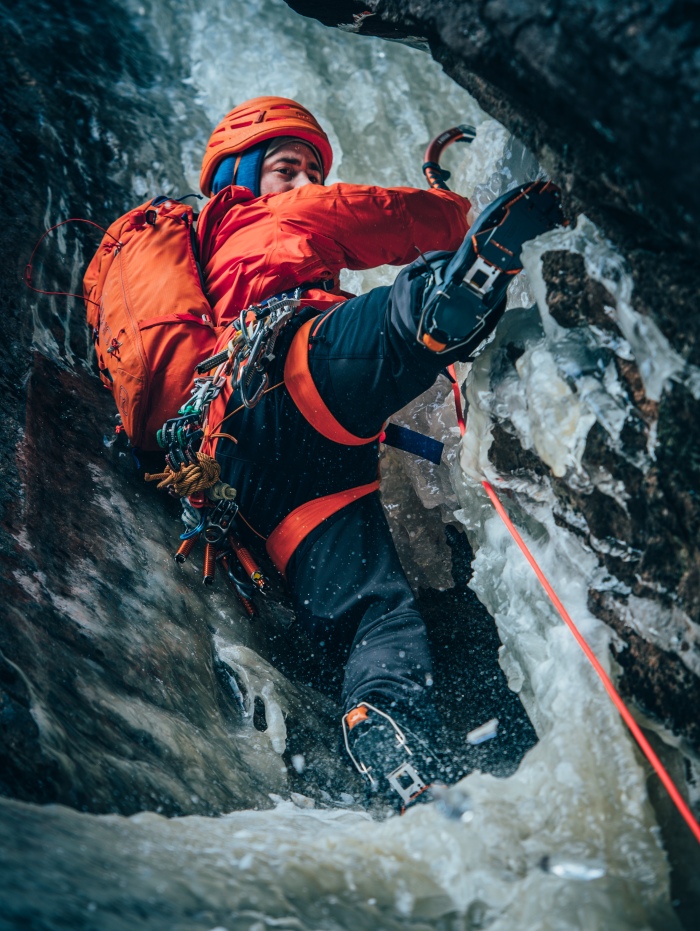Likely one of the most important choices a climber makes involves their footwear. Happy feet are so crucial for happy climbing and my feet have been quite happy the last few winters while I’ve been testing the Arc’Teryx Acrux AR Mountaineering Boots. Before I break into the details here is how they have been tested:
Mountaineering: (paired with Petzl Vasak Leverlock crampons)
Two full winters guiding in the Northeast with 4 winter ascents of Mount Washington with the lowest ambient air temperature around -20f and wind-chills around -50f. Some alpine climbing in the Cascades with ascents of Mount Shuksan, Forbidden Peak, and Rainier.

Waterfall Ice Climbing: (paired with Petzl Vasak Crampons, Black Diamond Cyborg’s, and CAMP/Cassin Blade Runner’s)
30+ pitches of waterfall ice climbing including Black Pudding Gully (WI4+), The Black Dike (WI4+) Drool of the Beast (WI5-) and Repentance (WI5).




I mention specifically what crampons I tested these with as this is a very important consideration when selecting a climbing boot, especially in this case and I will get into that further in the review. But first lets take a look at some of the details of this design.
I’ll start with some preliminary info from when I first received these boots back in October 2016.

“A pinnacle of design for mountaineering, ice and mixed climbing, the Acrux AR is the lightest, most durable, and lowest profile insulated double boot available.”- Arcteryx.com
That is a strong statement, and it happens to be true. Let’s compare some of the other lightweight double boots on the market:
La Sportiva Spantik (88.96 oz/pair)
La Sportiva Baruntse (82.96 oz/pair)
La Sportiva G2 SM (72.22 oz/pair)
Scarpa Phantom 6000 (70 oz/pair)
Arc’teryx Acrux AR (69.1 oz/pair)
This is actually less than an ounce difference than my La Sportiva Batura 2.0’s that I reviewed last winter here.
The obvious difference between these and my Batura’s is that these have a removable liner.


These liners “feel high-tech” in hand. I wore them around the house and they feel like a comfy slipper designed for astronauts. From arcteryx.com:
“Arc’teryx Adaptive Fit technology uses a removable bootie that employs stretch textiles and minimal seams to create an instant custom fit with no pressure. With protection extended beyond the cuff of the boot and the highest level of breathability in this category, the bootie’s GORE-TEX® membrane optimizes climate control and waterproof benefit. The perforated PE foam’s quick dry properties improve comfort, and a rubberized sole allows the bootie to be used as a camp shoe.”
Arc’teryx partnered with Vibram® and created the AR outsole using Vibram® Mont rubber which keeps its frictional properties in sub-zero temps.

“The specially developed Vibram® AR outsole is designed for support and sure footedness. The tread and construction feature a semi-blocked toe, with anti-slip grooves, a medial climbing support zone, and heel created to provide braking on steep descents. The Vibram® Mont rubber compound maintains its performance in sub-zero conditions.”
Now that I have had sufficient time in the field to test them let’s get into the question on everyone’s mind. How do these perform?
On the approach
Honestly these have been the most comfortable mountaineering boots I have yet to wear. They feel like they were custom made for my feet. For reference I am a US men’s size 9, EUR 42, medium width forefoot with a slight Morton’s toe. Unlike my previous double boots (Koflach Degre, Vertical, and Arctis Expe) it is easier to put this boot on by first putting the slim fitting liner on then sliding into the outer boot. When the liner is already in the boot it is a little more tricky to slide on but not impossible.
The lacing system is probably the only thing I could imagine being improved upon. There is no traction/tension grabber that is becoming common in a lot of boots in this category. For a boot at the high end of the category I would LOVE to see Arcteryx take it a step further and add a ratcheting lacing system like Boa.
As it stands I’ve adapted my lacing strategy. For general mountaineering and easy ice climbing I lace them at home and leave them all day. For harder ice climbing (WI4 and up) I’ll lace them at home, approach, then take the time at the base of the route to snug them up for better performance on the vertical. It doesn’t take long and leaving them loosely laced on steep ice can lead to some insecurity.
For comfort on the approach and descent these score very high. They are super light and warm enough for my feet in all the conditions I’ve tested them in. I do have “warm” feet though so if you suffer from cold feet I would suggest some solid test runs before going to significant altitude. The long term comfort is so significant that I’ve returned home after 14 hour days and left them on while stocking the wood stove and cooking dinner. No joke I have not felt the need to pull my feet out of these as soon as I get home even after significant slogs.
One of the reasons they might be so comfortable on the approach and descent is the small amount of flexibility within the shank/out-sole, a trait some who have tried them are concerned about, but one that I feel is easily remedied. I will elaborate more on that in the next section.
On the climb
The slim looking low profile Arc’Teryx Acrux AR Mountaineering Boots are the Lamborghini of the climbing boot world. Ok, that might be going a bit overboard but seriously I find these perform extremely well on steep water ice when paired with the right crampon. Why is the crampon pairing so important? Two reasons.
- These are super light boots. For hard ice climbs a heavier crampon might actually reduce your energy expenditure by giving your boot/crampon a better balance for efficient kicks. Before you call me crazy consider this is the same theory that explains the practice of adding pick weights to your ice axes. I find the heavier Black Diamond Cyborgs and CAMP Cassin Blade Runners to add a nice amount of weight allowing me to “kick lighter” and let the boot/crampon do the work. So super light boots are a plus for the approach and descent, but it’s nice to add a little mass for the kicking portion of your climb!
- These boots have some flex. That small amount of forefoot flex feels great on that 8 mile approach, but when you are front-pointing on near vertical ice having a secure platform takes precedence. I noticed the flex first when leading a 3+ route wearing my well worn Petzl Vasak Crampons. It wasn’t a big deal, but it was noticeable. I’ve since lead multiple grade 5 ice routes using the Black Diamond Cyborgs and CAMP Cassin Blade Runners and in all cases the inclusion of the stiff heavier crampon virtually eliminated all noticeable flexibility while front-pointing on both steep rock and ice.

Summary
Five months of some of the best Northeastern ice climbing I’ve had in years have left me with a super positive impression of the Arc’Teryx Acrux AR Mountaineering Boots. Slipper like comfort, 3-season like weight (yet still plenty warm for my feet), and high end performance when it matters most all add up to a fantastic new edition to the growing assortment of lightweight double boots. You should try a pair on!
UPDATE (10/22/2018)
Two years later and I’m still in love with these boots! I climbed Mount Shuksan, Forbidden Peak, and Rainier in them the following summer! You can see those trip reports here.
Buy on Backcountry
Thanks for reading! Take it one step further and comment below! Have you tried them? What did you think? What’s your current boot crampon/setup?
Disclaimer: Arc’Teyrx provided a pair of these boots for the purposes of review but all opinions expressed above are my own. Affiliate links help support the content created at Northeast Alpine Start at no additional cost to you! Thank you!


Great review! I wish I could afford them.
LikeLike
Great review! I would to get my hands on a pair of these. I have been running Batura 2.0 with Petzl Dartwins and have been very happy with them so far. 69oz for a double boot though, wow! Thanks for the review.
LikeLike
[…] mountaineering boots of choice, full review of them here. While I LOVE these boots for my cold New England ice climbing and mountaineering adventures they […]
LikeLike
[…] mountaineering boots of choice, full review of them here. While I LOVE these boots for my cold New England ice climbing and mountaineering adventures they […]
LikeLike
I’m looking for a boot predominantly for ice climbing. I noticed that you are wearing size 42.
People keep on telling me that for these boots to size up half to a full size bigger because you are wearing thicker socks, foot swelling and when you are bashing on the ice, you don’t want your toes to hit the front.
So I tried various models in size 43 and 43.5 and still can’t decide which size. So just wandering what size your Acrux AR end up being?
LikeLike
Hi Raphael! I ended up wearing my typical size in these. I’m a pretty Standard US 9, Eur 42, medium width with a slight Morton’s toe. I also wear regular hiking socks usually, though they have enough room for my thicker Mountaineering socks on really cold
Days. And with the right crampon and technique I find the boot holds my foot perfectly so no bashing toes when kicking. Hope this helps! They are awesome boots especially with the current sale!
LikeLike
[…] 30% off Arc’teryx ACRUX AR Mountaineering Boots! (use code ARC30 at checkout) My current favorite ice climbing boot with a very detailed review here! […]
LikeLike
[…] Without a doubt the most sleek and comfortable ice climbing boots I have ever worn. From Mount Rainier to Grade 5 waterfall ice in New England these have been a serious joy to wear. See my detailed review here. […]
LikeLike
Very strange that Arcteryx’s website suggests that these boots are 70 oz for 1/2 a pair (https://arcteryx.com/us/en/shop/Acrux-AR-Mountaineering-Boot)
LikeLike
Wondering if these would be warm enough for a summer ascent on Denali.
LikeLike
I’d say probably not. While they kept my feet warm on winder day ascents of Washington with ambient temps around -16 and wind chills around -40 these were faster moving single day pushes. For longer time at real altitude I would prefer a bit more insulation. Check out the La Sportiva Spantik if you haven’t already!
LikeLike
Excellent review David.
Well done!
LikeLiked by 1 person
Excellent review, thank you. I appreciate not only the awesome photography, but that crampon comparison. You nailed it!
LikeLiked by 2 people
[…] Arc’teryx Acrux AR GTX Mountaineering Boots– My in-depth review is here. […]
LikeLike
Stellar review as always! Thanks for your thoughts on both the Acrux and the Cassin!
I am lucky enough to own both the Acrux and the G2 SM. I have used the G2’s on 2 trips to Katahdin and have really loved them. I was able to save up my pennies (lots of them!) for Acrux as I’d like to get back into vertical ice and a buddy who gets out alot more than I can at the moment, LOVES them!
Not surprisingly, they are snug width wise. If there was any way to just bump out the toe box just a smidge they’d be perfect. Any thoughts on that or am I pretty much stuck with the fit as is? I know it’s not moldeable or anything…but maybe leaving a shoetree in there for a couple days?
In any event…I’m now on the hunt for a good pairing of a verticle ice crampon. The Cassin Blade Runner and the BD Cyborgs have been the ones catching my attention. I’d need it to pair well with either the Acrux or the G2. Sounds like you were quite happy with it’s fit to the Acrux and the performance. Heard any buzz on how it does (or doesn’t) play nice with LaSportiva’s G2 SM?
Thanks again for all your hard work on these reviews…they’ve helped immensely with my gear choices over the years! – Joshua
LikeLike
I’ve had a pair of these boots since 2017-18 season as well, and climb predominantly New England water ice. I probably got about 30 climbs in on these before the red bit on the toe exploded and exposed the toe to the inner gore-tex liner. I sent them back to Arc’teryx as a warranty middle of last season because there was an obvious gap between the red plastic and the inner boot, a clear weak spot in the part of the boot that takes the most abuse. (Bit of a custy service rant here) Anyway, they took about 3 months to respond that they even got my boots in BC. They then decided a month later that it was user error vs. product defect…. This might seem petty but I am thoroughly disappointed with Arc’teryx’ inability to back a product clocking in at $750 MSRP. I know many will argue that the damage is due to “Technique” and I fully agree with that, but if you’ve climbed NE ice you know where i’m coming from. I’ve seen one product tester with the same cracking that started during their tests (5 weeks in), Arc immediately replaced the boot to avoid this exposure.
I like this boot. I like the way it climbs, the warmth, and the fit. I’m just surprised how easily they broke, and how little the company stands behind their $$$ products.
I filled the toe with epoxy and covered the ripped up black rubber with roofing tape to try and get another season out of these boots.
Having had these boots for a similar amount of time David, I’m curious if you have had any durability issues since your last update.
Cheers,
Alan
LikeLike
Hello Alan,
Thank you for your comment and please accept my apology for the long delay in responding! I did experience a similar delimitation around the toe on one of my boots of the outer rand near the red rubber part… Around that time I also had an issue with the front zipper staying closed. This was after about 50 days in them and after my initial review. I sent them in for evaluation and they were replaced quickly (sounds similar to the other gear tester’s experience you mention). The 2nd pair has held up to two full season quite well and while I haven’t experienced the toe delamination issue on this go around I did start finding the zipper would sometimes not stay closed… I’ve been trying to figure out if there is an ideal angle for me to pull it up as some days it’s flawless and other days it takes a couple tries for me to get it closed correctly. I’m hoping to see an update to this model that maybe forgoes the zipper, or adds a velcro flap over it as a backup… and I would love to see them add the Boa lace system to a boot like this!
So while there are a couple durability issues I stand behind these being the most comfortable boots I’ve ever worn… Hopefully these issues can get addressed in a V2 model!
Thanks for reading and for the comment and questions!
Best,
David
LikeLike
[…] be lightweight for enhanced comfort without compromising performance. According to a review on the Northeast Alpine Start blog, these boots receive high praise for their comfort, lightweight design, and high performance […]
LikeLike